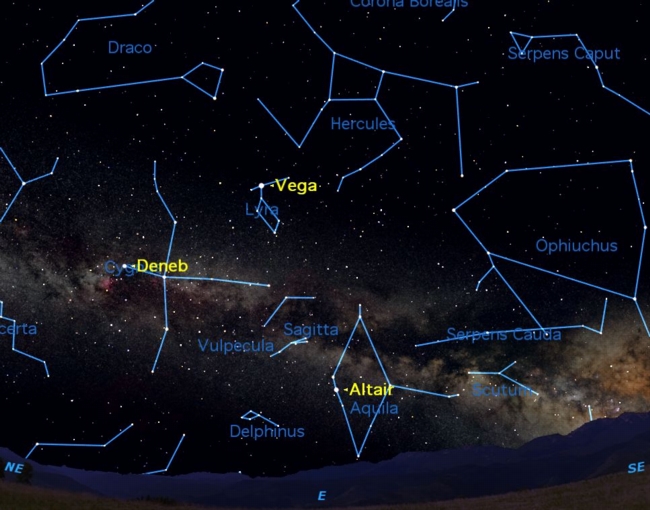How to See 'Future' Celestial Sights in Pre-Dawn Sky

Many busy people nowadays use DVRs to allow them to "time shift": recording TV programs today to view at another, more convenient, time. But did you know that you can do the same with the stars?
Over the course of each night, the Earth turns about 180 degrees on its axis. In the process, the stars overhead change almost completely, just as they do as the Earth travels around the sun over half the year. As a result, it is possible to see the stars of the next season or two just by staying up (and outside) extra late.
Right now, if you are a night owl or early bird, you can see the same sky that will be visible in late spring and early summer. Here's how to do it:
Get up an hour or so before sunrise and look eastward. The summer view of our Milky Way galaxy will be just rising and the Summer Triangle — a pattern made up of the bright stars Vega, Deneb, and Altair — will be well placed. The spring strongmen constellations of Bootes, Hercules, and Ophiuchus are also high overhead, offering an abundance of globular clusters for the observer with telescopes.
In the pre-dawn morning there are also two favorite planets to observe: Mars is nearing opposition now glowing bright red on the border between Virgo and Leo; and Saturn following close behind in Virgo.
Aside from getting the jump on the summer stars, time shifting has a special advantage for city dwellers. Many businesses turn their lights off after midnight to save money, so the light pollution in most cities can diminish noticeably in the early hours of the morning.
Finally, there's a special magic about observing in the early morning. The human world is quiet, and the natural world becomes more apparent. As the first light of dawn appears, you can hear nature awakening, especially the birds.
Breaking space news, the latest updates on rocket launches, skywatching events and more!
This article was provided to SPACE.com by Starry Night Education, the leader in space science curriculum solutions. Follow Starry Night on Twitter @StarryNightEdu.

Geoff Gaherty was Space.com's Night Sky columnist and in partnership with Starry Night software and a dedicated amateur astronomer who sought to share the wonders of the night sky with the world. Based in Canada, Geoff studied mathematics and physics at McGill University and earned a Ph.D. in anthropology from the University of Toronto, all while pursuing a passion for the night sky and serving as an astronomy communicator. He credited a partial solar eclipse observed in 1946 (at age 5) and his 1957 sighting of the Comet Arend-Roland as a teenager for sparking his interest in amateur astronomy. In 2008, Geoff won the Chant Medal from the Royal Astronomical Society of Canada, an award given to a Canadian amateur astronomer in recognition of their lifetime achievements. Sadly, Geoff passed away July 7, 2016 due to complications from a kidney transplant, but his legacy continues at Starry Night.
